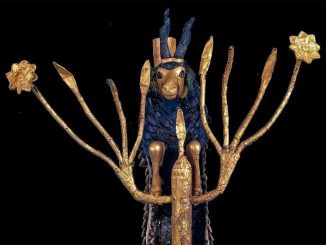Clothing not only protects people but also carries spiritual value, but experts are not sure exactly when clothes appeared.

Tarkhan Dress, a shirt made in ancient Egypt more than 5,000 years ago. Photo: Petrie Egyptian Archaeological Museum
It is difficult to know exactly when modern humans (Homo sapiens) began wearing clothes because of the lack of archaeological evidence for a definitive answer. The oldest direct evidence experts have is the Tarkhan Dress, a V-neck linen shirt discovered by Egyptologist Flinders Petrie in a tomb from the First Dynasty of ancient Egypt in Tarkhan cemetery. Carbon dating revealed that the shirt was produced around 3482 – 3102 BC.
It’s possible that people have worn clothes since before, but to date, archaeologists have not found any clothing item older than the Tarkhan Dress. This is not surprising because unlike today – when many clothes are made from synthetic fibers that are not biodegradable – ancient clothes were of plant and animal origin and easily decomposed, such as wool. or linen. It is possible that the Tarkhan Dress lasts so long because it is in an extremely dry environment, preventing deterioration.
The Tarkhan Dress is the oldest nearly complete piece of clothing ever discovered, but it is not the earliest evidence of textiles. For example, archaeologists have found fragments of plant-based textiles in the ancient settlement of Catalhoyuk, Türkiye, dating back about 8,500 years. This shows that people may have produced and worn clothes at that time.
Another much older piece of evidence was found in Dzudzuana Cave, Georgia, Türkiye, which is flax fiber. Some fibers are twisted and dyed with natural pigments. Researchers say this could be evidence for clothing making. Notably, these fabric fibers date back about 30,000 years, a significant leap in the time when clothes were born.
Scientists also use more special methods to trace the origin of clothes even further: based on lice. There are two types of lice that live on humans: those that live on the head and those that live on the body. The latter also live in clothing, so scientists say finding out when they appeared could provide indirect evidence about when humans started wearing clothes.
Researchers compared the DNA of head and body lice to determine when the latter type appeared. A recent estimate shows that body lice likely diverged from head lice about 83,000 – 170,000 years ago. However, this is only a rough estimate. Body lice will need time to adapt, so clothing may come out a little before this time.
That’s just evidence of when modern people wore clothes. In addition, experts also discovered traces showing that Neanderthals may have also worn fur coats. However, the longer it takes, the harder it is to find direct evidence. Therefore, perhaps people will never know exactly when clothes were born.v


